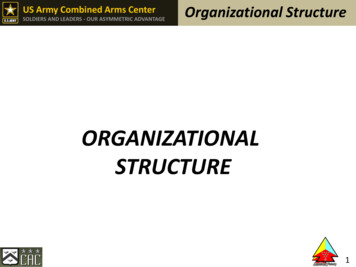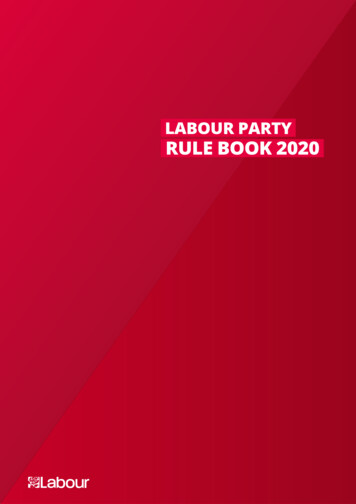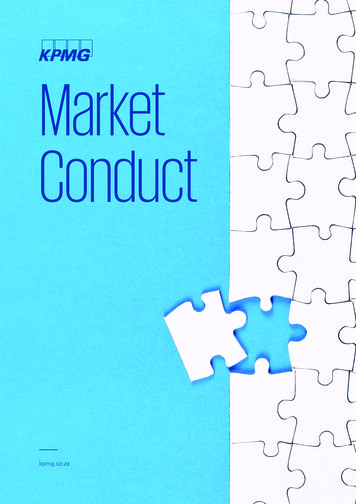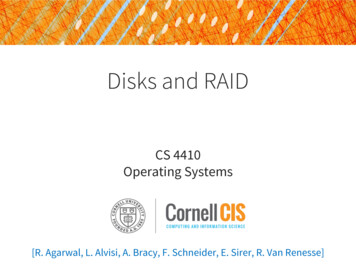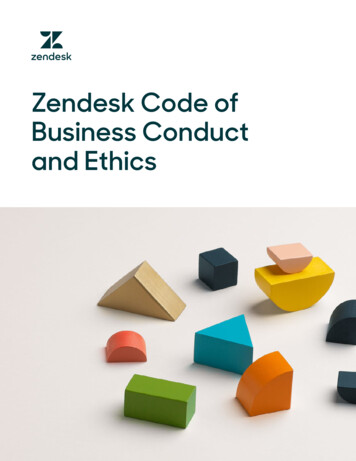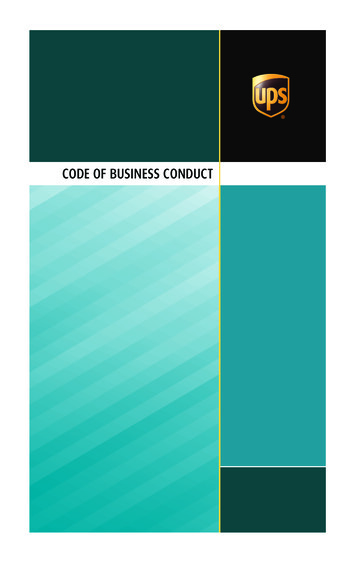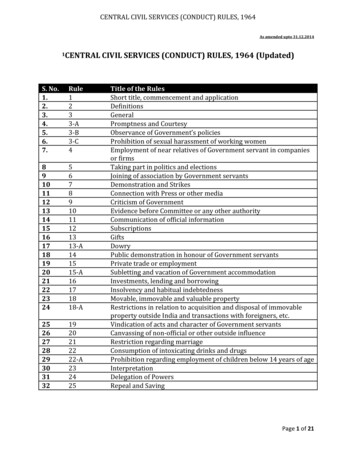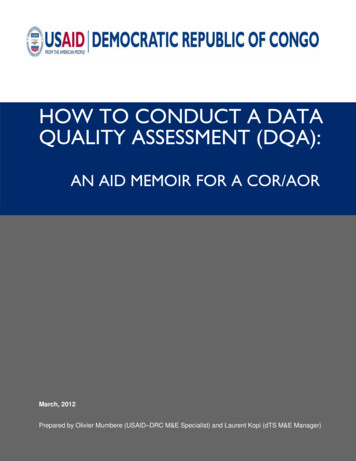
Transcription
HOW TO CONDUCT A DATAQUALITY ASSESSMENT (DQA):AN AID MEMOIR FOR A COR/AORMarch, 2012Prepared by Olivier Mumbere (USAID–DRC M&E Specialist) and Laurent Kopi (dTS M&E Manager)
IDAutomated Directive System.Contracting Officer’s RepresentativeData Collection MethodologyDevelopment and Training ServicesData Quality AssessmentDevelopment ObjectiveDemocratic Republic of the CongoImplementing PartnerMonitoring and EvaluationPerformance Monitoring PlanPerformance Management PlanPerformance Indicators Reference SheetPerformance Plan ReportUnited States Agency for International DevelopmentHow to conduct DQA in DRC: an Aid – memoir for COR ‐ AORPage ii
TABLE OF CONTENTSACRONYMS . iiTABLE OF CONTENTS . iiiBACKGROUND . 1FIRST PART: ESSENCE OF DQA . 1WHAT’S THE DATA QUALITY ASSESSMENT? . 1WHAT ARE THE MAIN TYPES OF DQAS? . 2WHAT ARE THE KEY CONCEPTS RELATING TO DQA? . 3PART II: HOW TO CONDUCT DQA . 4WHAT iS THE ROLE OF THE COR/AOR IN THE DQA PROCESS?. 4WHAT ARE THE KEY STEPS FOR CONDUCTING DQA DURING THE LIFE OFTHE PROJECT? . 5HOW DO YOU CONDUCT A DQA DURING A FIELD VISIT? . 6PART III: NEXT STEPS AND POTENTIAL CHALLENGES . 7HOW TO REPORT DQA? . 7WHAT ARE THE FREQUENT CHALLENGES AROUND THE DQA PROCESS?. 7CONCLUSION . 10ANNEX 1: INITIAL DATA QUALITY ASSESSMENT INFORMATION SHEET . 11ANNEX 2: DATA QUALITY ASSESSMENT CHECKLIST . 13ANNEX 3: DATA QUALITY SELF-ASSESSMENT (OPTIONAL) . 16ANNEX 4: DQA Steps . 18ANNEX 5: FURTHER REFERENCES. 20How to conduct DQA in DRC: an Aid – memoir for COR ‐ AORPage iii
BACKGROUNDThe Government Performance and Results Act (GPRA) established strategic and Performance Planning andMonitoring and Evaluation requirements for all USG Agencies. In accordance with the Office ofManagement and Budget (OMB) guidance, USAID contributes to or prepares detailed planning and reportingdocuments that cover programs funded in each fiscal year.USAID-funded projects are most often implemented through grants, cooperative agreements, or contracts.These mechanisms are built upon solid principles of partnership. Despite its strong belief in partnership,USAID values the quality of data provided by partners. To this end, USAID conducts Data QualityAssessments (DQAs) in accordance with Automated Directives System (ADS) 203 in an effort to understandand increase the quality of the data that it reports on regularly.According to the ADS, the purpose of a DQA is to ensure that the USAID Mission and the Technical officesoverseeing an activity are aware of the strengths, weaknesses, and limitations of their performance data as wellas the extent to which the data can be trusted to influence management decisions. A DQA of each selectedperformance indicator helps validate the usefulness and integrity of the data.The ADS mandates that “Data reported to USAID/Washington for GPRA reporting purposes or forreporting externally on Agency performance must have a data quality assessment at some time within thethree years before submission.” (ADS 203.3.5.2) Through a DQA, Missions should ensure that the data beingreported are measured against five data quality standards: validity, integrity, precision, reliability and timeliness(abbreviated V-I-P-R-T).The ADS requires Missions to: 1) review data collection, maintenance, and processing procedures to ensurethat procedures are consistently applied and continue to be adequate; 2) identify areas for improvement, ifpossible; and 3) retain documentation of the DQA in their performance management files and update theinformation within three years.The DQA is also an opportunity for building capacities, and improving reporting quality. Thus, the DQAhelps end-users of USAID data to know strengths and limitations of the data on which their programs report.FIRST PART: ESSENCE OF DQAWHAT’S THE DATA QUALITY ASSESSMENT?The ADS does not prescribe a specific way to conduct a data quality assessment. There are a variety ofapproaches that can be used. Documentation may be as simple as a memo to the files or it could take theform of a formal Data Quality Assessment (DQA) report. The most appropriate approach will reflect anumber of considerations such as management need; the type of data collected, the data source, theimportance of the data, or suspected data quality issues. The key is to document the findings-- whetherformal or informal.A DQA focuses on applying the data quality criteria and examining the systems and approaches for collectingdata to determine whether they are likely to produce high quality data over time. In other words, if the dataquality criteria are met and the data collection methodology is well designed, then it is likely that good qualitydata will result.HOW TO CONDUCT A DATA QUALITY ASSESSMENT 1
This “systematic approach” is valuable because it assesses a broader set of issues that are likely to ensure dataquality over time (as opposed to whether one specific number is accurate or not). For example, it is possibleto report a number correctly, but that number may not be valid.As mentioned above, the purpose of a DQA is to assess the data management systems of USAID’sImplementing Partners (IPs), by analyzing program indicators using data quality standards of validity,integrity, precision, reliability, and timeliness (V-I-P-R-T). These five standards are defined below in Table 1.A DQA assesses the quality of data and information an IP submits by analyzing the process used to collect,store, and transmit data to USAID/DRC. It highlights strengths and weaknesses of partners’ primary andsecondary data and provides recommendations for improving the data management system of the IP. Insum, a DQA: Assesses the quality of data submitted by these IPs in relation to the V-I-P-R-T data quality standards.Assesses the system that the IP uses to collect and analyze data.Assesses the management information system the partner uses to record, maintain, and report data.Identifies areas of potential vulnerability that affect the general credibility and usefulness of the data.Recommends measures to address any identified weaknesses in the data submitted by the IP and in theM&E procedures and systems in place at the partner’s level.Table 1: DQA STANDARDSSTANDARDDEFINITIONValidityData should clearly and adequately represent the intended results. While proxy data may be used, theMission must consider how well the data measure the intended result. Another issue is whether datareflect bias, such as interviewer bias, unrepresentative sampling, or transcription bias.IntegrityWhen data are collected, analyzed, and reported, there should be mechanisms in place to reduce thepossibility that they are intentionally manipulated for any reason. Data integrity is at greatest risk ofbeing compromised during data collection and analysis.PrecisionData should be precise enough to present a fair picture of performance and enable managementdecision making at the appropriate levels. One issue is whether data is at an appropriate level of detailto influence related management decisions. A second issue is whether or not the margin of error (theamount of variation normally expected from a given data collection process) is acceptable given themanagement decisions likely to be affected.ReliabilityData should reflect stable and consistent data collection processes and analysis methods over time.The key issue is whether analysts and managers would come to the same conclusions if the datacollection and analysis process were repeated. The Mission should be confident that progress towardperformance targets reflects real changes rather than variations in data collection methods. When datacollection and analysis change, PMPs should be updated.TimelinessData should be timely enough to influence management decision making at the appropriate levels. Onekey issue is whether the data are available frequently enough to influence the appropriate level ofmanagement decisions. A second is whether data are current enough when they are reported.WHAT ARE THE MAIN TYPES OF DQAS?The DQA is an assessment exclusively focused on the quality of data. It is not an audit conducted onselected indicators – even though some data quality issues may sometimes question the nature of indicatorsselected for a given project. USAID/DRC has decided to characterize three main categories of DQAs:HOW TO CONDUCT A DATA QUALITY ASSESSMENT 2
1. The Initial DQA: is an assessment of the monitoring and evaluation systems established by theUSAID COR/AOR and the IP management staff. This initial DQA will ensure that data collectedthrough the systems set in place will be of good quality. The assessment will review: the tools to beused for collecting data, the qualifications of data collectors, the existence of sound methodologies inthe organization, the number of persons or entities who will be processing the data before it reachesthe headquarter’s office, the security of the data, and the accessibility to data within the institution(hard copy and electronic copy protection). This DQA will also assess the risks which may affect thequality standards including Validity, Integrity, Precision, Reliability, and Timeliness.2. The DQA during Project implementation: this DQA is conducted amidst the activities of theproject. It takes advantage of the recommendations from the initial DQA report or therecommendations from a previous DQA report. This handbook is focused on providing guidancefor conducting this type of DQA.3. The Data Quality Self-Assessment: this is a self-assessment that is conducted by the IP of theirdata collection systems. This can be attached as an appendix to the DQA report and serves as a wayto fully involve the IP in the DQA process.WHAT ARE THE KEY CONCEPTS RELATING TO DQAS?1. Data Quality Assessment: is a review of performance indicator data against a set of data qualitystandards that helps the Mission determine and document “How good are the data”, and provide anopportunity for capacity building of implementing partners, host government ministries, and otherpartners.2. Data Quality Standards: there are five data quality standards: Validity, Integrity, Precision,Reliability, and Timeliness. (See Table 1 above)3. Primary data: are data collected directly by USAID or another entity contracted by USAID.USAID has a high level of control over these data, and should apply all the quality standards. Also,the Mission can outsource quality assessment services from specialized experts. When the missioncollects primary data on its own or through independent entities contracted by USAID for thispurpose, the DQA should focus on the written procedures and training for crosschecking data.When contracting a specific organization to collect data, the Mission will ensure that the organizationhas the technical capacity to collect data of appropriate quality, as evidenced by the following: Written procedures are in place for data collection; Data are collected from year to year using consistent collection process; Data are collected using methods to address and minimize sampling and non-samplingerrors; Data are collected by qualified personnel that are properly supervised; Duplicative data is detected; Safeguards are in place to prevent unauthorized changes to the data; and, Source documents are maintained and readily available.HOW TO CONDUCT A DATA QUALITY ASSESSMENT 3
Data quality requirements should be written in a Statement of Work (SOW), Request for Proposal (RFP),or Request for Application (RFA). The Mission should also maintain communication with theimplementing team to spot check that quality assurance mechanisms are being used. If this contract iscentrally-managed, then the Contracting Officer Representative (COR) or Agreement OfficerRepresentative (AOR) will establish and maintain quality control over the data collection and analysis.4. Secondary data: are data collected by other sources, such as host country governments,implementing partners, or from other organizations. The range of control that USAID has oversecondary data varies. For example, if USAID uses data from a survey commissioned by anotherdonor, then there is little control over the data collection methodology. On the other hand, USAIDdoes have more influence over data derived from implementing partners. USAID should verifywhether data collected are of reasonable quality based on the five data quality standards of validity,integrity, precision, reliability, and timeliness. The Mission will focus its assessment on the apparentaccuracy and consistency of the data. USAID may not always have the right to audit or investigatethe quality of data in depth, depending on what is written in the agreement.Further actions: The Mission should consider visiting a broad range of sites; the point is to assess whetherreports submitted reflect accurately what occurs in the field. The Mission should conduct regular meetings with other development partners to gainappreciation of how accurate the data are and how much credence can be placed in thefigures cited. Request the IP M&E person to provide a briefing on the data collection and analysisprocedures, including procedures to reduce error. Data quality assessment findings should be documented in a memo to the Program Office’sfile.5. Data Collection Methodology: is a set of principles fully documented and applied by the IP tocollect data from the field. A more comprehensive documentation on data collection methodologyshould be provided by the Development Objective (DO) team to each of its IPs. To this end, DOteams should share their PMP (Performance Management Plans which include PerformanceIndicator Reference Sheets) with their IPs.PART II: HOW TO CONDUCT DQAWHAT IS THE ROLE OF THE COR/AOR IN THE DQA PROCESS?Conducting DQAs is the responsibility of COR/AOR. After the Performance Plan and Report, every DOteam should come up with a list of indicators that should undergo a DQA during the next fiscal year. GoodDQA planning helps the Mission to avoid conducting DQAs in emergency mode which can negativelyimpact the quality of the DQA process. CORs/AORs are strongly encouraged to conduct DQAs duringHOW TO CONDUCT A DATA QUALITY ASSESSMENT 4
their planned site visits. This is more cost-efficient and provides room for in-depth discussion with the IP inthe field. The M&E Specialist of the mission is available to support DO teams in conducting DQAs.WHAT ARE THE KEY STEPS FOR CONDUCTING DQA DURING THE LIFE OF THEPROJECT?1. For Mission-Managed ProjectsWhen the AOR/COR is based at the Mission, she/he can proceed with following steps:1. Gather key documents of the projects: PMP of the Development Objective team, Project MonitoringPlan, monthly or quarterly reports from the IP (especially those covering the period starting from thelast date of the DQA).2. Read and note relevant questions on indicators.3. Visit a flagship activity of the project (or the one providing the bulk of indicators’ data).4. Meet with the IP (Project Managers and M&E staff of the IP).5. Provide a quick debriefing of the DQA findings with the IP management team.6. Draft the DQA report (Executive summary, Introduction, Findings, Conclusion, andRecommendations).7. Share the draft report with the DO team, COR/AOR and with the IP for comments and formalacknowledgement of the report’s findings.8. File the DQA report in the official award files and send to the Mission’s M&E Specialist for theProgram Office files.2. For Centrally-Managed ProjectsCentrally-funded projects are projects managed by a Washington-based COR/AOR. Therefore, any attemptto conduct a DQA should be discussed beforehand with the Washington-based COR/AOR. The ActivityManager is the one who will serve as liaison between the COR/AOR and the Implementing partner. TheActivity Manager will be accountable for following actions:Administrative and Logistic Steps1. Draft an email to the COR/AOR stating the rationale for conducting the DQA and provide aproposed timeframe for the DQA and list of targeted indicators.2. Share the email and its response with the Chief of Party (CoP) of the IP.3. Gather key project documents: the PMP of the Development Objective team, Project MonitoringPlan (of the activity), monthly or quarterly reports from the IP (especially those covering the periodsince the previous DQA).4. Read and document any concerns raised from the document review.Information Gathering and DQA Process1. Visit a flagship activity of the project (or the one providing the bulk of indicators’ data).2. Meet with M&E staff from the IP in order to understand their data collection processes andmethodologies.3. Provide a quick debriefing of the DQA findings with the IP management team.4. Draft the DQA report (Executive summary, Introduction, Findings, Conclusion, andRecommendations).5. Share the draft Report with the DO team, COR/AOR, and with the IP for comments and formalacknowledgement of the report’s findings.HOW TO CONDUCT A DATA QUALITY ASSESSMENT 5
6. File the DQA report in the official award files and send to the Mission’s M&E Specialist for theProgram Office files.HOW DO YOU CONDUCT A DQA DURING A FIELD VISIT?It is always good to conduct the DQA as a team, but if for operational reasons there are not enoughresources for this, one person can conduct the DQA and report on behalf of the team. The DQA team mustassess the data quality of standard indicators that the IPs report on through their activity by using the DQAChecklist for COR/AORs (Annex II) to conduct the DQA in steps as follows:1. Review the recommendations of a previous DQA report2. Assess the data collection system and processes: Ask whether a reporting calendar covering data collection exists. Check whether evidences of data quality discussions exist across the organization (memos,minutes). Review the definition of the indicator along with its data collection methodology. Obtain a clear picture of how data is transferred from the field to the IP’s M&E desk. Compare a randomly selected sample of the data provided by the IP’s Headquarter Office withthe data found in the field office (to determine accuracy).3. Assess the qualification of staff assigned to data collection, analysis and storage: Identify key persons in the M&E system that have direct or indirect relationship with the datacollected. Ask whether people assigned to data collection are fully trained or simply aware of the existenceof the official data collection methodology provided by the DO hand book or by the PIRS.4. Assess the data storage systems: Review the electronic files and make sure that passwords exist in order to access stored data. Find out the number and the responsibilities of people authorized to access the data storagesystem. Review the archived or stored files. Assess the vulnerability of the electronic system in place (risk of massive loss of data forexample).5. Conduct a field visit to data sources to make sure you have a clear picture of challenges the IPencounter in the data collection process (visiting two data generating sites is recommended).6. Review data compliance with the five data quality standards including validity, integrity, precision,reliability, and timeliness.7. Complete the DQA Checklist for each indicator, and a DQA self-assessment should be filled in bythe IP’s M&E specialist.8. Prepare a short debriefing to the IP’s field office: Schedule a 30-minute discussion with key personnel of the organization. Discuss orally key findings with the IP. Discuss options for capacity building or improving data quality.The following issues may be found in the field (the list is not exhaustive):HOW TO CONDUCT A DATA QUALITY ASSESSMENT 6
Double counting: this problem is frequently encountered. During the DQA, the DQA expertwill help the IP on a case-by-case basis to reduce the pervasive effects of double counting ondata validity.Lack of data source documents: IPs should be encouraged to track data from trainingsessions (through lists of participants or lists of beneficiaries).Potential data manipulations: During the DQA process, it will be worthwhile to assess thepresence of implementers during data processing in the field office. Weak abilities of M&E staffin the field to monitor their programs could lead to potential data manipulations that wouldreduce data validity.PART III: NEXT STEPS AND POTENTIAL CHALLENGESHOW TO DRAFT A DQA REPORT?1. Draft the DQA report and share it with the IP: The report should:o Outline the overall approach and methodology used in conducting the DQA;o Highlight key data quality issues that are important for senior management; and,o Summarize recommendations for improving performance management systems. The conclusion of the report should logically flow from the key findings. The report should be no more than ten pages, including the DQA checklist, and focused onthe most relevant findings. The AOR/COR should ensure that the IP agrees with the final version of the report beforesharing it with the Program Office. Continue to follow up on recommendations during future site visits.2. Share the Final Version of the DQA report with the Program Office for official filing The Program Office will file DQAs conducted at the Mission. At any time, the PO shouldprovide auditing teams with proof of Mission’ compliance with Agency data qualitystandards. The official COR/AOR project files should also maintain DQA records.WHAT ARE THE FREQUENT CHALLENGES AROUND THE DQA PROCESS?Usually, the DO team will be confronted with the issue of finding out the best approach for conductingDQAs (i.e. informal, semi-formal, or formal DQAs). Figure 1 below presents a spectrum of informal, semiformal, and formal DQA options.Informal options: Informal approaches can be driven by specific issues as they emerge. These approachesdepend more on the program manager’s in-depth knowledge of the program. Findings are documented bythe program manager in memos or notes in the Performance Management Plan.HOW TO CONDUCT A DATA QUALITY ASSESSMENT 7
Figure 1. Options for Conducting Data Quality Assessments- The ContinuumInformal Options Ongoing (driven by emergingand specific issues)Semi-Formal/ PartnershipOptionsFormal Options Driven by broaderprogrammatic needs Periodic & systematic More dependent on themanager’s expertise &knowledge of the program. Conducted by the programmanager. Product: Documented inmemos, notes in the PMP Draws on both management More dependent on technicalexpertise and/or specifictypes of data expertiseexpertise and M&E expertise Facilitated and coordinated bythe M&E expert, but AOteam members are activeparticipants Product: May be a Data Product: Data QualityQuality Assessment report oraddressed as a part ofanother report.Assessment ReportExample: An implementer reports that civil society organizations (CSOs) have initiated 50 advocacycampaigns. This number seems unusually high. The project manager calls the Implementer to understandwhy the number is so high in comparison to previously reported numbers and explores whether a consistentmethodology for collecting the data has been used (i.e., whether the standard of reliability has been met). Theproject manager documents his or her findings in a memo and maintains that information in the files.Informal approaches should be incorporated into Mission systems as a normal part of performancemanagement.Advantages Managers incorporate data quality as a part of on-going work processes. Issues can be addressed and corrected quickly. Managers establish a principle that data quality is important.Disadvantages It is not systematic and may not be complete. That is, because informal assessments are normallydriven by more immediate management concerns, the manager may miss larger issues that are notreadily apparent (for example, whether the data are attributable to USAID programs). There is no comprehensive document that addresses the DQA requirement. Managers may not have enough expertise to identify more complicated data quality issues, auditvulnerabilities, and formulate solutions.Semi-Formal Options/Partnership optionsSemi-formal or partnership options are characterized by a more periodic and systematic review of dataquality. These DQAs should ideally be led and conducted by USAID staff. One approach is to partner amonitoring and evaluation (M&E) expert with the Mission’s DO team to conduct the assessment jointly. TheM&E expert can organize the process, develop standard approaches, facilitate sessions, assist in identifyingpotential data quality issues and solutions, and may document the outcomes of the assessment. This optionHOW TO CONDUCT A DATA QUALITY ASSESSMENT 8
draws on the experience of DO team members as well as the broader knowledge and skills of the M&Eexpert. Engaging program managers in the DQA process has the additional advantage of making them moreaware of the strengths and weaknesses of the data.Advantages Produces a systematic and comprehensive report with specific recommendations for improvement. Engages DO team members in the data quality assessment. Draws on the complementary skills of front line managers and M&E expert. Assessing data quality is a matter of understanding trade-offs and context in terms of deciding whatdata is “good enough” for a program. An M&E expert can be useful in guiding DO team membersthrough this process in order to ensure that audit vulnerabilities are adequately addressed. Does not require a large external team.Disadvantages Requires time commitment from DO team members. The Mission may use an internal M&E expert or hire someone from the outside. However, hiring anoutside expert will require additional resources, and external contracting requires some time. Because of the additional time and planning required, this approach is less useful for addressingimmediate problems.Formal OptionsAt the other end of the continuum, there may be a few select situations where Missions need a more rigorousand formal data quality assessment.Example: A Mission invests substantial funding into a high profile program that is designed to increase theefficiency of water use. Critical performance data comes from the Ministry of Water, and is used both forperformance management and reporting to key stakeholders, including the Congress. The Mission is unsureas to the quality of those data. Given the high level interest and level of resources invested in the program, adata quality assessment is conducted by a team including technical experts to review data and identify specificrecommendations for improvement. Recommendations will be incorporated into the technical assistanceprovided to the Ministry to improve their own capacity to track these data over time. These types of dataquality assessments require a high degree of rigor and specific, in-depth technical expertiseAdvantages Produces a systematic and comprehensive assessment, with specific recommendations. Examines data quality issues with rigor and based on specific, in-depth technical expertise Fulfills two important purposes, in that it can be designed to improve data collection systems bothwithin USAID and for the beneficiary.Disadvantages Often conducted by an external team of experts, entailing more time and cost than other options. Generally less direct involvement by program managers. Often examines data through a very technical lens. It is important to ensure that broadermanagement issues are adequately addressed.HOW TO CONDUCT A DATA QUALITY ASSESSMENT 9
CONCLUSIONConducting a DQA is an important exercise for CORs/AORs and allows them to fully understand the datathey are reporting on. DO teams should invest efforts and time to understand the strengths and weaknessesof data that they report on.Planning DQAs at the DO level and integrating them into planned field trips helps save financial resources,and is a rewarding exercise for USAID project managers. By planning ahead to conduct DQAs in the field,CORs/AORs can streamline the DQA process and tailor it to each activity’s needs.HOW TO CONDUCT A DATA QUALITY ASSESSMENT 10
ANNEX 1: INITIAL DATA QUALITY ASSESSMENT INFORMATIONSHEETUse this model for the initial DQA with an implementing partner. It is best that these interviews be conducted on the partnerpremises, to
A DQA focuses on applying the data quality criteria and examining the systems and approaches for collecting data to determine whether they are likely to produce high quality data over time. In other words, if the data quality criteria are met and the data collection methodology is well designed, then it is likely that good quality data will result.

